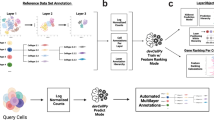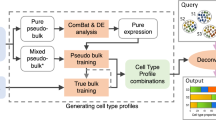Abstract
CellNet is a computational platform designed to assess cell populations engineered by either directed differentiation of pluripotent stem cells (PSCs) or direct conversion, and to suggest specific hypotheses to improve cell fate engineering protocols. CellNet takes as input gene expression data and compares them with large data sets of normal expression profiles compiled from public sources, in regard to the extent to which cell- and tissue-specific gene regulatory networks are established. CellNet was originally designed to work with human or mouse microarray expression data for 21 cell or tissue (C/T) types. Here we describe how to apply CellNet to RNA-seq data and how to build a completely new CellNet platform applicable to, for example, other species or additional cell and tissue types. Once the raw data have been preprocessed, running CellNet takes only several minutes, whereas the time required to create a completely new CellNet is several hours.
This is a preview of subscription content, access via your institution
Access options
Access Nature and 54 other Nature Portfolio journals
Get Nature+, our best-value online-access subscription
$29.99 / 30 days
cancel any time
Subscribe to this journal
Receive 12 print issues and online access
$259.00 per year
only $21.58 per issue
Buy this article
- Purchase on Springer Link
- Instant access to full article PDF
Prices may be subject to local taxes which are calculated during checkout







Similar content being viewed by others
References
Murry, C.E. & Keller, G. Differentiation of embryonic stem cells to clinically relevant populations: lessons from embryonic development. Cell 132, 661–680 (2008).
Ieda, M. et al. Direct reprogramming of fibroblasts into functional cardiomyocytes by defined factors. Cell 142, 375–386 (2010).
Kyba, M., Perlingeiro, R.C.R. & Daley, G.Q. HoxB4 confers definitive lymphoid-myeloid engraftment potential on embryonic stem cell and yolk sac hematopoietic progenitors. Cell 109, 29–37 (2002).
Bock, C. et al. Reference maps of human ES and iPS cell variation enable high-throughput characterization of pluripotent cell lines. Cell 144, 439–452 (2011).
McKinney-Freeman, S. et al. The transcriptional landscape of hematopoietic stem cell ontogeny. Cell Stem Cell 11, 701–714 (2012).
Hussein, S.M.I. et al. Genome-wide characterization of the routes to pluripotency. Nature 516, 198–206 (2015).
Davidson, E.H. & Erwin, D.H. Gene regulatory networks and the evolution of animal body plans. Science 311, 796–800 (2006).
Cahan, P. et al. CellNet: network biology applied to stem cell engineering. Cell 158, 903–915 (2014).
Morris, S.A. et al. Dissecting engineered cell types and enhancing cell fate conversion via CellNet. Cell 158, 889–902 (2014).
Berger, D.R., Ware, B.R., Davidson, M.D., Allsup, S.R. & Khetani, S.R. Enhancing the functional maturity of iPSC-derived human hepatocytes via controlled presentation of cell-cell interactions in vitro. Hepatology 61, 1370–1381 (2014).
Godoy, P. et al. Gene networks and transcription factor motifs defining the differentiation of stem cells into hepatocyte-like cells. J. Hepatol. 63, 934–942 (2015).
Song, G. et al. Direct reprogramming of hepatic myofibroblasts into hepatocytes in vivo attenuates liver fibrosis. Cell Stem Cell 18, 797–808 (2016).
Cao, N. et al. Conversion of human fibroblasts into functional cardiomyocytes by small molecules. Science 352, 1216–1220 (2016).
Uosaki, H. et al. Transcriptional landscape of cardiomyocyte maturation. Cell Rep. 13, 1705–1716 (2015).
Lu, Y.-F. et al. Engineered murine HSCs reconstitute multi-lineage hematopoiesis and adaptive immunity. Cell Rep. 17, 3178–3192 (2016).
Pavlidis, N. & Fizazi, K. Carcinoma of unknown primary (CUP). Crit. Rev. Oncol. Hematol. 69, 271–278 (2009).
Bian, Q. & Cahan, P. Computational tools for stem cell biology. Trends Biotechnol. 34, 993–1009 (2016).
Müller, F.J. et al. A bioinformatic assay for pluripotency in human cells. Nat. Methods 8, 315–317 (2011).
Avior, Y., Biancotti, J.-C. & Benvenisty, N. TeratoScore: assessing the differentiation potential of human pluripotent stem cells by quantitative expression analysis of teratomas. Stem Cell Reports 4, 967–974 (2015).
Roost, M.S. et al. KeyGenes, a tool to probe tissue differentiation using a human fetal transcriptional atlas. Stem Cell Reports 4, 1112–1124 (2015).
Rackham, O.J.L. et al. A predictive computational framework for direct reprogramming between human cell types. Nat. Genet. 48, 331–335 (2016).
D'Alessio, A.C. et al. A systematic approach to identify candidate transcription factors that control cell identity. Stem Cell Reports 5, 763–775 (2015).
Cieply, B. et al. Multiphasic and dynamic changes in alternative splicing during induction of pluripotency are coordinated by numerous RNA-binding proteins. Cell Rep. 15, 247–255 (2016).
Mertens, J. et al. Differential responses to lithium in hyperexcitable neurons from patients with bipolar disorder. Nature 527, 95–99 (2015).
Martin, M. Cutadapt removes adapter sequences from high-throughput sequencing reads. EMBnet. J. 17, 10–12 (2011).
Patro, R., Duggal, G., Love, M.I., Irizarry, R.A. & Kingsford, C. Salmon provides fast and bias-aware quantification of transcript expression. Nat. Methods 14, 417–419 (2017).
Anders, S. & Huber, W. Differential expression analysis for sequence count data. Genome Biol. 11, R106 (2010).
Mouse ENCODE Consortium. An encyclopedia of mouse DNA elements (Mouse ENCODE). Genome Biol. 13, 418 (2012).
Xu, H. et al. ESCAPE: database for integrating high-content published data collected from human and mouse embryonic stem cells. Database 2013, bat045 (2013).
Correa-Cerro, L.S. et al. Generation of mouse ES cell lines engineered for the forced induction of transcription factors. Sci. Rep. 1, 167 (2011).
Margolin, A.A. et al. Reverse engineering cellular networks. Nat. Protoc. 1, 662–671 (2006).
Margolin, A.A. & Califano, A. Theory and limitations of genetic network inference from microarray data. Ann. N. Y. Acad. Sci. 1115, 51–72 (2007).
Faith, J.J. et al. Large-scale mapping and validation of Escherichia coli transcriptional regulation from a compendium of expression profiles. PLoS Biol. 5, e8 (2007).
Rosvall, M. & Bergstrom, C.T. Maps of random walks on complex networks reveal community structures. Proc. Natl. Acad. Sci. USA 105, 1118–1123 (2008).
Acknowledgements
P.C. is supported by the National Institute of Diabetes and Digestive and Kidney Diseases (NIDDK; grant no. K01DK096013). We thank E. Appleton for helpful comments on the protocol.
Author information
Authors and Affiliations
Contributions
A.H.R. wrote code, performed analysis, and wrote the manuscript. R.M.S. wrote code and performed analysis. Y.T. analyzed data, debugged code, and edited the manuscript. J.K. debugged code and analyzed data. E.K.W.L. analyzed data and edited the manuscript. P.C. devised the method, wrote code, analyzed data, wrote the manuscript, and oversaw the project.
Corresponding author
Ethics declarations
Competing interests
The authors declare no competing financial interests.
Integrated supplementary information
Supplementary Figure 1 Comparison of GRN performance based on either total counts normalization or DESeq.
X-axis represents the Z-score for the predicted transcription factor- to target genes interactions. The Y-axis represents the area under the precision recall curve relative to randomly generated GRNs. AUPR was calculated as described previously8 using three sets of TF-to-target gene annotations as gold standards. The first gold standard is derived from lists of genes whose promoters are bound by transcription factors as determined by Chip-Seq data produced as part of the mouse ENCODE project28. The second gold standard is the Escape database, which is a compilation of genes whose promoters are bound by transcription factors in mouse embryonic stem cells defined by Chip-Chip or Chip-Seq data29. The third gold standard is derived from the determination of genes that are differentially expressed upon acute induction of one of 94 transcription factors ('Ko': named after the surname of the senior author of the associated study30).
Supplementary information
Supplementary Figures and Text
Supplementary Figure 1 and Supplementary Tables 1 and 2. (PDF 725 kb)
Rights and permissions
About this article
Cite this article
Radley, A., Schwab, R., Tan, Y. et al. Assessment of engineered cells using CellNet and RNA-seq. Nat Protoc 12, 1089–1102 (2017). https://doi.org/10.1038/nprot.2017.022
Published:
Issue Date:
DOI: https://doi.org/10.1038/nprot.2017.022
This article is cited by
-
A comprehensive transcriptomic comparison of hepatocyte model systems improves selection of models for experimental use
Communications Biology (2022)
-
Ranking reprogramming factors for cell differentiation
Nature Methods (2022)
-
Transcriptomics analysis of human iPSC-derived dopaminergic neurons reveals a novel model for sporadic Parkinson’s disease
Molecular Psychiatry (2022)
-
Characterizing the composition of iPSC derived cells from bulk transcriptomics data with CellMap
Scientific Reports (2022)
-
Evaluating the transcriptional fidelity of cancer models
Genome Medicine (2021)
Comments
By submitting a comment you agree to abide by our Terms and Community Guidelines. If you find something abusive or that does not comply with our terms or guidelines please flag it as inappropriate.



